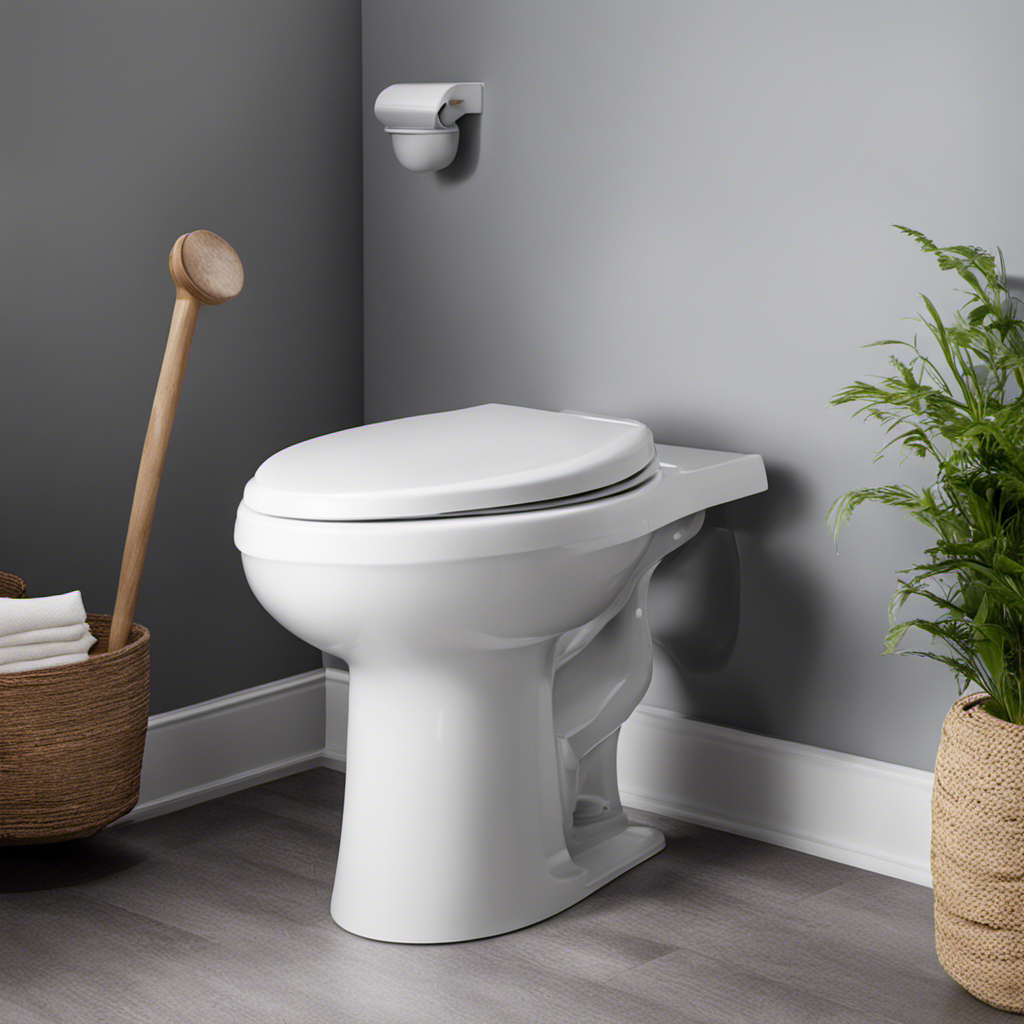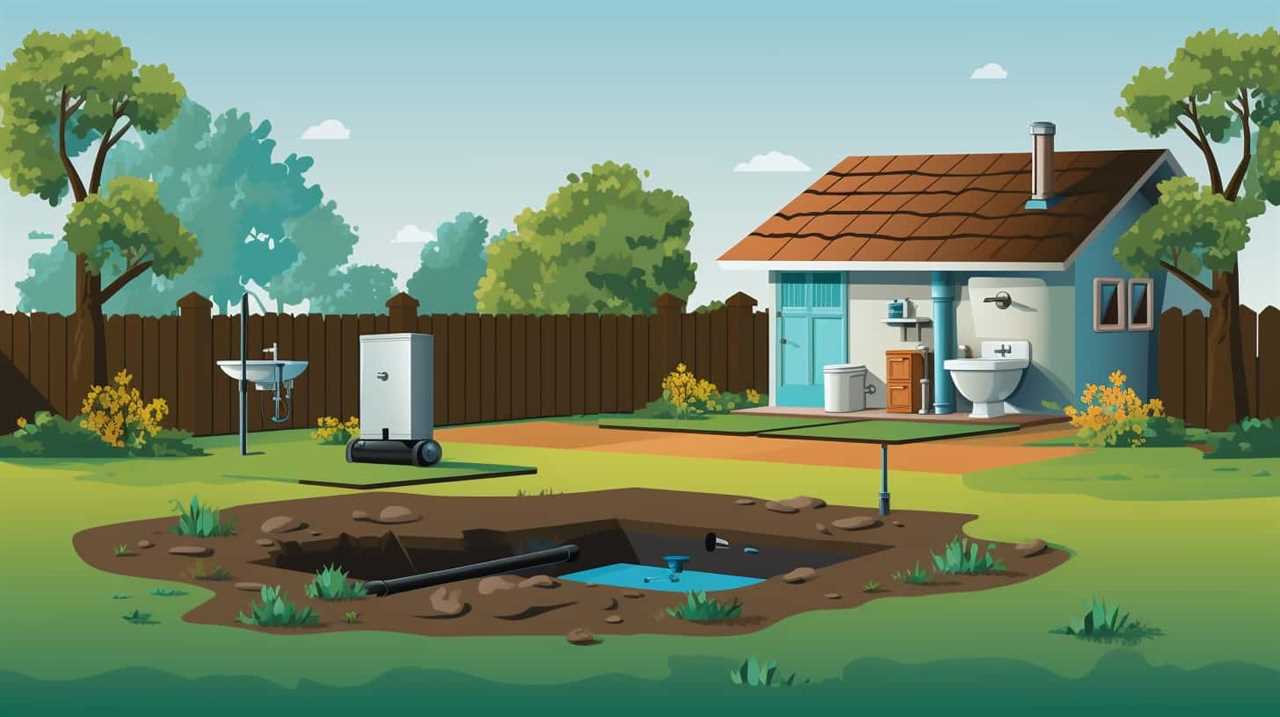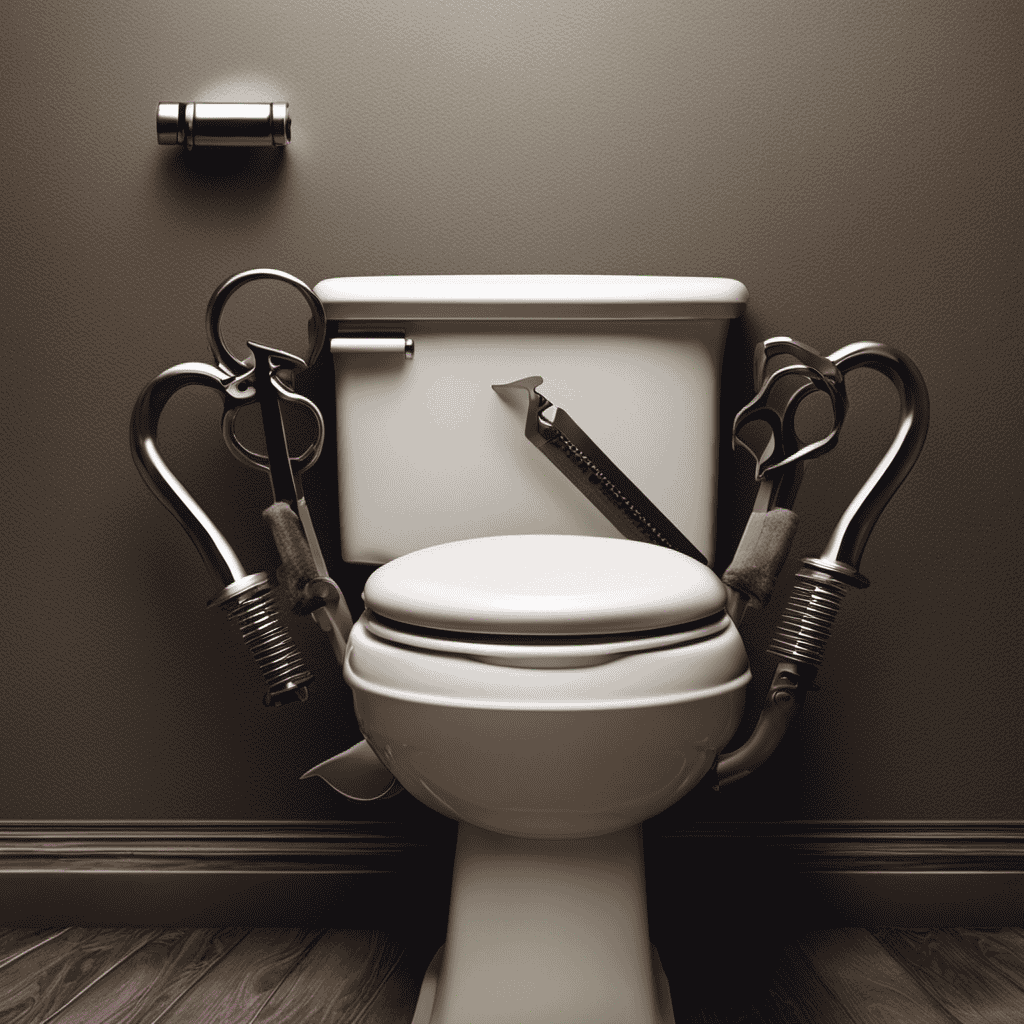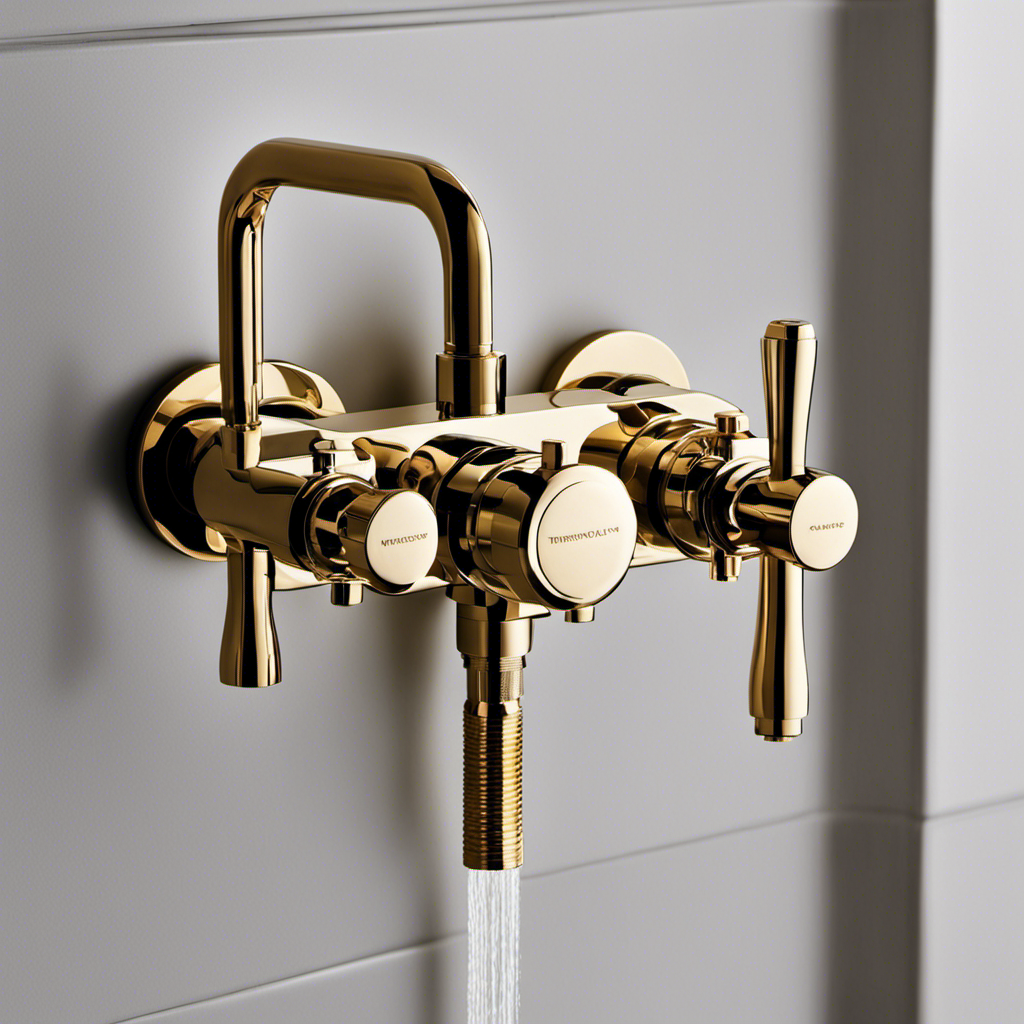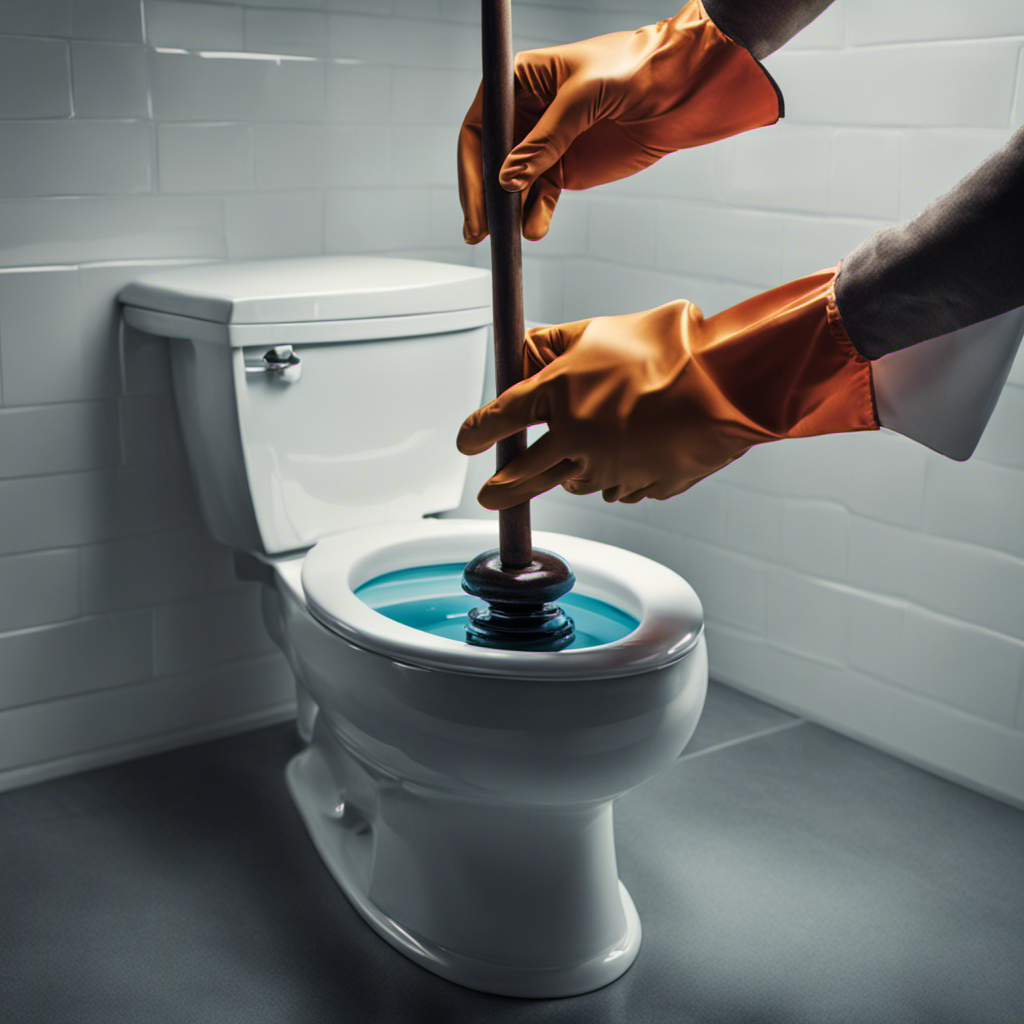Did you know that clogged toilets are one of the most common household plumbing issues? It’s a frustrating situation that can disrupt your daily routine.
But fear not, because I’ve got the solution for you. In this article, I’ll guide you through the step-by-step process of how to plunge a toilet effectively. With my experienced advice and detailed instructions, you’ll be able to tackle any toilet clog like a pro.
Let’s dive in and get your bathroom back in working order!
Key Takeaways
- There are different types of plungers available, such as flange plungers and cup plungers, each suitable for different types of clogs.
- It is important to properly maintain the plunger by cleaning it with hot water and soap after each use and storing it in a dry place to prevent bacteria growth.
- Regular maintenance of the toilet, including plunging, can prevent costly repairs and water damage in the future.
- When plunging a toilet, it is important to securely place the rubber suction cup over the drain hole, remove excess water from the bowl, and use the correct plunging technique to loosen the blockage.
Types of Plungers
There are two main types of plungers: the flange plunger and the cup plunger. Each has its advantages and disadvantages when it comes to unclogging toilets.
The flange plunger, also known as a toilet plunger, has a rubber cup with a flange on the bottom. This design allows for a better seal around the drain, making it more effective at removing blockages.
On the other hand, the cup plunger, often used for sinks and tubs, has a flat rubber cup without a flange. While it may not create as tight of a seal as the flange plunger, it can still be effective for minor clogs.
Proper maintenance of plungers is important to ensure their longevity. After each use, it’s crucial to clean the plunger with hot water and soap, and then store it in a dry place to prevent the growth of bacteria.
With the right plunger and proper care, you can tackle toilet clogs with confidence. Now, let’s move on to gathering the necessary supplies.
Gathering the Necessary Supplies
First, you’ll need to grab a pair of rubber gloves to protect your hands while completing this task.
Toilet maintenance is an essential part of preventing plumbing problems in your home. By taking the necessary steps to keep your toilet in good condition, you can avoid costly repairs and potential water damage.
To gather the necessary supplies for toilet maintenance, start by getting a plunger. Look for one with a rubber suction cup that fits the drain hole of your toilet. Additionally, you may want to have a toilet brush, a bucket, and a bottle of toilet bowl cleaner. These tools will help you keep your toilet clean and functioning properly.
Regular maintenance is key to a well-functioning toilet, and it’s a simple task that can save you from future headaches.
Preparing the Toilet for Plunging
To get started, you’ll want to ensure that the rubber suction cup of the plunger is securely placed over the drain hole. This creates a tight seal, allowing for maximum suction when you begin plunging. Properly preparing the toilet for plunging is crucial to effectively unclogging it. Before you start plunging, it’s important to remove any excess water from the bowl. This can be done using a bucket or a cup. Once the water level is low, you can begin the plunging process. With a firm grip on the plunger handle, push down forcefully and then pull up quickly. Repeat this motion several times until you feel the blockage start to loosen. Remember to maintain a steady rhythm and keep the suction cup firmly in place. With proper toilet maintenance and regular plunging, you can prevent clogs and keep your toilet running smoothly.
| Dos | Don’ts |
|---|---|
| Be patient and persistent | Use harsh chemicals |
| Use a plunger with a suction cup | Flush repeatedly |
| Create a tight seal over the drain hole | Forcefully plunge |
| Use a bucket or cup to remove excess water | Ignore warning signs |
| Maintain a steady rhythm while plunging | Neglect regular toilet maintenance |
Proper Plunging Technique
When it comes to properly plunging a toilet, there are a few key points to keep in mind.
First, correct hand positioning is crucial for effective plunging. By gripping the handle firmly and positioning the rubber cup over the drain, you’ll be able to generate the necessary force to clear the clog.
Second, applying steady pressure is essential for a successful plunge. Rather than frantically plunging up and down, it’s important to use controlled and consistent movements to create suction and dislodge the obstruction.
Lastly, using a proper seal is vital to prevent any water or air from escaping during the plunging process. Ensuring a tight seal between the rubber cup and the toilet bowl will optimize the suction power and increase the chances of unclogging the toilet successfully.
Correct Hand Positioning
Make sure you’re holding the plunger with both hands in a firm grip to ensure correct hand positioning. Proper hand hygiene is crucial before and after plunging a toilet to prevent the spread of bacteria and maintain a clean environment. To illustrate the importance of hand hygiene and toilet maintenance, let’s take a look at the following table:
| Hand Hygiene | Toilet Maintenance |
|---|---|
| Reduces germs on hands | Prevents clogs |
| Protects against infections | Eliminates foul odors |
| Promotes overall cleanliness | Maintains proper flushing |
Apply Steady Pressure
Applying steady pressure is key to effectively unclogging a toilet. When it comes to plunging, it’s not just about randomly pushing up and down. You need to know how to apply force and maintain pressure to get the job done right.
Here are four steps to help you plunge a toilet successfully:
-
Position the plunger correctly: Make sure the rubber cup completely covers the drain opening. This will create a seal and allow you to apply maximum force.
-
Push down firmly: Use your body weight to apply pressure on the plunger. This will create a strong suction and help dislodge the clog.
-
Pull up forcefully: After pushing down, quickly pull up on the plunger while maintaining a tight seal. This action will help loosen any stubborn debris.
-
Repeat if necessary: If the clog persists, repeat the plunging process until the water starts to drain freely.
Use a Proper Seal
Using a plunger with a proper seal is crucial for effectively unclogging a toilet. When it comes to plunging, the seal between the plunger and the toilet bowl is what creates the necessary pressure to dislodge the clog.
To achieve a proper seal, start by positioning the plunger over the drain hole, making sure it covers the entire opening. Press down firmly to create suction, and then give it a few vigorous up and down motions. The key is to maintain the seal throughout the process to maximize the effectiveness of each plunge.
By using a plunger with a proper seal, you can ensure that the force generated is focused on breaking up the clog, leading to a successful unclogging.
Once you have mastered the art of effective plunging, it’s important to be aware of common issues that may arise during the process.
Troubleshooting Common Issues
When it comes to dealing with clogged toilets, I’ve had my fair share of experience and learned some valuable solutions along the way. From my perspective, it’s crucial to have a range of effective techniques at your disposal to unclog a toilet. These techniques include using a plunger, a toilet auger, or a homemade mixture of hot water and dish soap.
However, it’s equally important to prevent future blockages. This can be done by being mindful of what you flush down the toilet and implementing regular maintenance practices. Using a drain strainer and avoiding excess toilet paper usage are good habits to adopt.
Clogged Toilet Solutions
One solution for a clogged toilet is to try using a plunger. It’s a simple yet effective tool that can help dislodge and clear blockages in the toilet drain.
Here are four techniques to unclog a toilet using a plunger:
-
Proper positioning: Ensure the plunger is covering the hole completely to create a good seal. This will maximize suction and increase the chances of success.
-
Firm yet controlled plunging: Use an up-and-down motion with the plunger, applying steady pressure. Avoid using excessive force, as it may damage the toilet bowl or cause water to splash out.
-
Repeat the process: If the clog persists, repeat the plunging process several times. This can help dislodge and break apart the obstruction.
-
Flush and check: Once the clog is cleared, flush the toilet to ensure proper drainage. If the water flows smoothly, congratulations! You’ve successfully unclogged your toilet.
Preventing Future Blockages
Regular maintenance and adopting preventive measures can help you avoid future blockages in your toilet. Troubleshooting techniques and maintenance tips are essential in keeping your toilet functioning properly.
One important step is to avoid flushing anything other than toilet paper and human waste down the toilet. Items like paper towels, feminine products, and baby wipes can easily cause clogs.
Additionally, it is important to regularly clean your toilet, including the inside of the bowl and the jets underneath the rim. This will help prevent the build-up of mineral deposits and other debris that can lead to blockages.
Another key maintenance tip is to check the water level in the tank periodically. If it is too low, the toilet may not flush properly, leading to potential blockages.
Cleaning up After Plunging
After you’ve plunged the toilet, it’s important to clean up any remaining water and debris. Here are four essential cleaning techniques and disinfecting methods to ensure a thorough and sanitary cleanup:
-
Gather the necessary supplies: Grab a pair of rubber gloves, a bucket, disinfectant cleaner, and paper towels or a mop.
-
Remove excess water: Use a wet/dry vacuum or a sponge to soak up any remaining water in the toilet bowl. Be sure to dispose of the water properly.
-
Scrub the bowl: Apply a generous amount of disinfectant cleaner to the toilet bowl, focusing on the areas that came into contact with the blockage. Use a toilet brush to scrub thoroughly and remove any stains or residue.
-
Disinfect the surrounding area: Wipe down the toilet seat, lid, and the entire surrounding area with a disinfectant cleaner. Pay attention to any surfaces that may have been splashed with water during the plunging process.
Preventing Future Toilet Clogs
To prevent future clogs, make sure to be mindful of what you flush down the toilet and avoid disposing of items that can easily cause blockages. Proper toilet maintenance and regular drain cleaning are essential to keeping your toilet functioning smoothly.
It’s important to use toilet paper sparingly and avoid flushing items like wipes, feminine hygiene products, or paper towels, as they can easily get stuck in the pipes and cause a blockage. Additionally, consider installing a drain strainer or hair catcher to prevent hair and other debris from going down the drain.
Regularly cleaning the toilet and the surrounding area can also help prevent the buildup of dirt and grime, reducing the chances of clogs. By following these simple steps, you can ensure a clog-free toilet and avoid costly plumbing repairs.
Frequently Asked Questions
How Long Does It Typically Take to Plunge a Toilet?
It typically takes a few minutes to plunge a toilet. By using proper toilet plunging techniques, you can quickly unclog the toilet. Avoid common mistakes like using too much force or not creating a proper seal with the plunger.
Can Plunging a Toilet Cause Any Damage to the Plumbing?
Plunging a toilet with a toilet plunger can potentially cause damage to the plumbing if not done correctly. It’s important to use gentle, controlled force to avoid causing any cracks or leaks in the pipes.
What Should I Do if Plunging Doesn’t Unclog the Toilet?
If plunging doesn’t unclog the toilet, don’t panic. First, check for any signs of toilet overflow. If there’s none, try using a toilet auger. If all else fails, it’s time to call a professional.
Is It Necessary to Wear Gloves When Plunging a Toilet?
When plunging a toilet, it’s important to consider sanitation. Wearing gloves can provide an extra layer of protection against any potential germs or bacteria. It’s always better to be safe than sorry.
Can I Use a Plunger for Other Purposes Besides Unclogging a Toilet?
Yes, you can use a plunger for creative solutions and alternative household uses besides unclogging a toilet. It’s amazing how versatile this tool can be when you think outside the box.
Conclusion
In conclusion, plunging a toilet may seem like a daunting task, but with the right technique and tools, it can be easily resolved.
Remember to choose the appropriate plunger and gather all the necessary supplies beforehand.
Prepare the toilet by ensuring there is enough water in the bowl and creating a tight seal with the plunger.
Use a firm yet controlled motion when plunging, and don’t be afraid to troubleshoot common issues if they arise.
Lastly, clean up thoroughly and take preventive measures to avoid future clogs.
With these tips, you’ll be a toilet-plunging pro in no time!
And remember, don’t be a square, give that plunger some flair!
